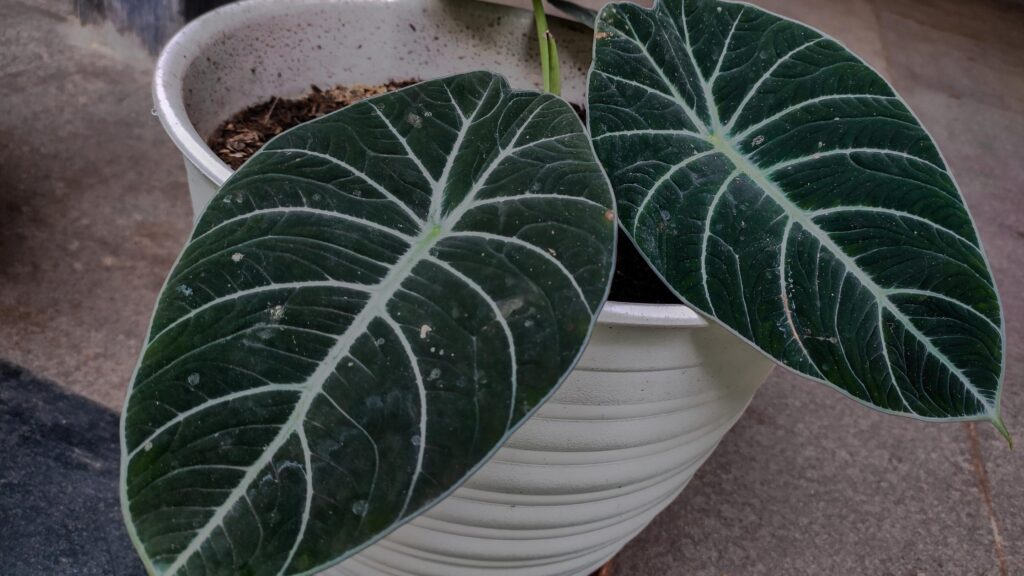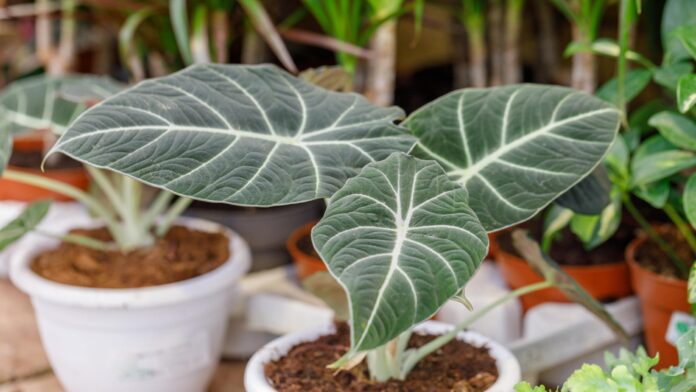Table of Contents
Alocasia Black Velvet, also distinguished as Black Velvet Elephant Ear, is a prized houseplant that captivates with its deep, almost black leaves and contrasting silver veins. This comprehensive guide provides insights into effectively cultivating this stunning variety, ensuring it thrives in your home or office environment.
Understanding the Alocasia Black Velvet
Alocasia Black Velvet is part of the Araceae family, originating from Southeast Asia’s tropical forests. Unlike its larger cousins typically known for their expansive foliage, this compact perennial prefers the understory, making it ideal for indoor settings where space and direct sunlight are limited.
Optimal Growing Conditions
Light Requirements: Alocasia Black Velvet flourishes under bright, indirect light. The ideal placement is near a north or east-facing window where the light is dappled and soft. Direct sunlight should be avoided as it can cause the leaves to scorch, while insufficient light can lead to leggy growth and a loss of leaf vibrancy.
Soil and Watering Needs: The soil should be well-draining and rich in organic matter. A mix of perlite, peat moss, and loam is favorable, helping maintain even moisture without becoming soggy. Water the plant when the top inch of soil feels dry, ensuring thorough hydration without waterlogging, which prevents issues like root rot.
Caring for Humidity and Temperature
Alocasia Black Velvet’s tropical lineage means it thrives in high-humidity environments, ideally around 60% or higher. Utilize a humidifier, or place the plant on a pebble tray with water to enhance the surrounding humidity. As for temperature, maintain a range between 65°F to 75°F (18°C to 24°C). Protect the plant from drafts and drastic temperature changes to prevent stress.
Feeding and Maintenance
Fertilizing: Feed your Alocasia Black Velvet with a balanced, diluted houseplant fertilizer every month during the spring and summer. Reduce feeding in the winter months when the plant’s growth naturally slows down.
Pruning and Cleaning: Regularly clean the leaves with a soft, damp cloth to remove dust and support photosynthesis. Prune away any yellowed or dead leaves to focus the plant’s energy on new growth and maintain its aesthetic appeal.
Propagation Insights
Propagating Alocasia Black Velvet is most effectively done through division. During repotting, gently separate the rhizomes and plant them individually. This method encourages the growth of new, healthy plants. Seed propagation is feasible but less common and typically more challenging.
Potting and Repotting Tips
Repot your Alocasia Black Velvet every two to three years or when it becomes root-bound. Choose a container slightly larger than the previous one to facilitate continued growth. Spring is the best time for repotting, offering the plant a full growing season to establish.

Common Pests and Plant Diseases
Monitor for signs of pests such as spider mites, especially in dry conditions. Maintaining high humidity can help prevent infestations. Be vigilant about the plant’s moisture levels and drainage to avoid diseases like root rot.
Toxicity Precautions
It’s crucial to remember that Alocasia Black Velvet is toxic to both humans and pets if ingested. Always handle with care, particularly during repotting, and keep the plant out of reach of children and animals.
Conclusion
Alocasia Black Velvet is not just a plant; it’s a statement piece that brings a touch of the exotic to any indoor space. With proper care and attention, it will thrive and beautify your home for years to come.
FAQ
Q: How often should Alocasia Black Velvet be watered?
Water when the top inch of soil is dry, typically once a week, but adjust based on humidity and temperature conditions.
Q: Can Alocasia Black Velvet be grown outdoors?
It can be grown outdoors in very warm, humid climates where temperatures do not drop below 60°F (15°C).
Q: What are the signs that my Alocasia Black Velvet needs repotting?
Signs include roots growing through the drainage holes and slowed growth, indicating it may be root-bound.
Q: How can I increase humidity for my Alocasia Black Velvet?
Use a humidifier, mist the plant regularly, or place it on a pebble tray with water.
Q: Is Alocasia Black Velvet suitable for beginners?
Due to its need for specific humidity and light conditions, it might be challenging for beginners but is manageable with careful attention to its care requirements.
Q: What should I do if the leaves of my Alocasia Black Velvet start turning yellow?
Yellow leaves can be a sign of overwatering or poor drainage. Check the moisture level of the soil and adjust your watering schedule accordingly.



